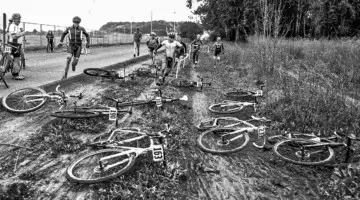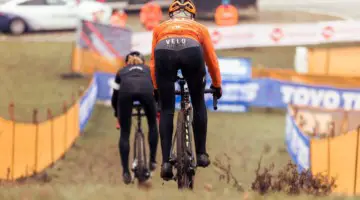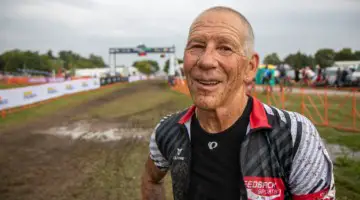Mid-November is here, and that means we are in the heart of cyclocross season. The weather has turned ugly in some parts of the country, but state championshps and Nationals and their accompanying glory and sense of achievement also lurk right around the corner for many of us.
Staying motivated, fresh and sharp can be really challenging this time of year. Nearly a year of riding adds up, and bad weather conditions can make getting ready to race feel like a chore.
That said, things do not need to be gloomy. Coach Chris Mayhew returns to help provide some advice for staying fresh and motivated when the gales of November and the holiday season come calling.
We asked Mayhew some of the questions on our minds this time of year. If you have questions of your own, feel free to chime in in the comments or reach out to Mayhew via Twitter @csmayhew.
Staying Fit and Fresh in November with Coach Chris Mayhew
Cyclocross Magazine: With mud anticipated at Nationals, if you live in a non-muddy place, what skills can you work on between now and then and how can you work on them? What can you do to mentally prepare for muddy conditions?
Chris Mayhew: I think mud is primarily about a few simple concepts. First, to quote Marc Vettori. “Half of being a mudder is telling yourself you are one.” Cyclocross, in general, is about riding the wrong bike for the conditions. And mud is about being in over your head and how you deal with that.
To the first point and last point, as much as you can, focus on being and staying positive. But also have a plan for when things go bad. This podcast was really eye (or ear) opening.
You are going to crash. So is everyone else. As much as you can be mentally ready for that.
To address the middle points, do whatever you can to put yourself in over your head. Ride in the rain. Ride file treads (or even slicks). Ride your road bike instead of your cyclocross bike. Make the worst equipment choices you can in terms of traction and handling and go train. Low tire pressure will work too.
Ride with people faster than you are on technical terrain and try to keep up. Ride early in the morning or near sunset if the grass will be wet around that time. Pine tree needles are great for riding around on ball (needle?) bearings. Sand works too.
Anything you can do to get uncomfortable and “fail faster” to quote Tim Kennedy is what you’re looking for. All of that will transfer to mud pretty well.
I think I covered the mental aspect above. I’d say get comfortable failing, having a plan B (and thinking about that plan) and envisioning what you’re doing to do when things go wrong.
A lot of people racing in mud seem to envision that their competition never fell, when really that’s not the case at all. It’s more about who crashed one less time or who didn’t let those crashes get inside their head. Acquire all the calming and positive self-talk techniques you can.

Racing in the mud is 90% mental and the other half is physical. 2018 Louisville Cyclocross Nationals, Saturday and Sunday. © Drew Coleman
Lastly, due to the low-cadence nature of heavy mud races, there are some physical things you could do. I am always a fan of core work. McGill Big Three and shoulder taps, three times a week.
You could also do big gear stuff. If you wanted to do your normal workout but one or two gears higher, I think that’s fine. Singlespeed might be the best single thing you could do. Get used to functioning at a wide variety of cadences.
CXM: Less-than-ideal call-ups are a way of life at Nationals. What should you focus on to balance starting well versus not doing something dumb due to the stress?
CM: I think people place too much importance on call ups. I’ve seen a lot of pros win from the back, and I’ve certainly experienced good results after missing my call-ups. And at this point, the call-up systems are reasonably good about predicting where you’re going to end up. Placing your hopes on beating the predictor by 10 spots is a recipe for disappointment (as are all results-based goals I suppose).
Look at is this way, with a hampered start you’re not going to be able to set fire to your entire matchbook in the first half lap of the race. You’ll start slower, but you’ll have the entire race duration to burn matches and pick people off. Focus on clean passes and keeping your eyes forward on the next rider. People get in trouble when they force passes or bury themselves thinking 1 min of max-effort is going to change their race.
CXM: It looks like there will be at least one run-up at Nationals. If you have not focused on running at this point in the season, is there value in adding some running efforts, or is it too late?
CM:There’s always time! The first few weeks of a new skill or strength are largely about neuromuscular rewiring. So even a few weeks of running are going to help you in that regard, even if you aren’t actually a better runner.
With that in mind, I’d keep the efforts very specific. Use stairs or a steep hill, make the efforts the estimated length and duration of the run and keep it somewhat ’cross-specific. So, for instance, do a run-up of some sort, hop on your bike and drill it for 30 seconds. Recover for 30-60 seconds and do 6 of those. You’ll be flying with that sort of work.
And running up hills generates less impact which should cut down on soreness. (I’d also tell you to add some protein to your diet. Cyclists are really bad about that and it will help cut down on DOMS).

Short bursts up stairs can be a good way of training this time of year. 2018 Pan-American Cyclocross Championships, Midland, Ontario. © Z. Schuster / Cyclocross Magazine
CXM: Illnesses can really take their toll this time of year. What should you do when you come down with a cold with respect to training and racing?
CM: First and foremost don’t freak out. People spend so much energy worrying about being sick or losing form or wondering if they are getting sick. That’s a lot of energy that could be spent recovering or training.
I think it depends on what you’re sick with and how well you deal with things. In general, I think a day off to recover is way better than limping along for a week. Take a day off, see if you feel better. If you don’t, take the time you need and don’t make things worse by training.
And see a doctor if you need to. If you need antibiotics or a short round of steroids for a sinus infection the sooner the better.
Then wait till you’re actually better to start training. So many time I’ve ridden myself into something worse on the third day of an antibiotic.
CXM: Many of us have state championships or Nationals after Thanksgiving, is it okay to leave the bike at home if you’re traveling to see family?
CM: Yes, it’s ok to be a normal human and not a professional amateur for a day. I’d also say don’t paint yourself into a corner. Organize your week and month so that Thursday is a recovery day, a planned day off the bike. Get a little creative with your plan.
CXM: What are some things you can sneak in during Thanksgiving to help with fitness?
CM: Fit riding in where it’s the least amount of hassle for other people. You always own your morning, maybe you get up early for some intervals. On the flip side, there’s usually a lull late in the day where you can get out for an hour. Almost no one hangs up non stop all day with family.
Find a short workout you can do. Tabatas, 8 x 1′, 10 ’cross starts. Something short and compact but quality. You can do a lot with a focused hour, or less.
My current favorite hack is to ride back from places. Twice now my wife has dropped me off in the middle of nowhere Kentucky to let me ride back from a family outing. Post family outing is a great downtime to get some bike riding in.
Running is an obvious answer too but don’t do that if you haven’t been doing running before now.
CXM: If you’re tapering for States or Nats, what should that look like from a training perspective?
CM:In general a taper starts about 10-14 days out. Intensity is maintained or increased, but volume should be cut down quite a bit. You’ve built all your fitness at this point. It’s about staying sharp, using the taper to hit peak numbers (sparingly!!) and letting your body rest. Fitness is built from recovery, not training.
CXM: The ’cross season can really take its toll at this point. Do you have advice on, say, shutting it down versus finding a way to maybe take a break and get another good race or two in?
CM: One of my all-time favorite things to do as a coach is to talk people out of races. Any time it becomes “I should race” or something along those lines it’s time for a break, at least. If you’re that burned out, take a few days off and see where you stand.
My personal philosophy this season is to make sure it’s fun. I sign up for one race at a time, and when it stops being fun, I’ll stop for the season. That’s worked really well for me so far.
When planning for next year, be really proactive about your schedule. You know you’re going to get burned out around this time. Everyone does. Find some time in the middle of the season to take a break and reload on training for a bit.
Or, know that you’re going to pull the plug in mid-November and plan on that rather than taking a “Well, let’s see” approach to your season. I’ve already planned out with every client back in July or August when we’re going to take a break midseason.
And one weekend off is not going to kill you. I skipped racing this weekend. I might race in December, we’ll see when I get there. At this point, for anyone not going to Nationals, being fresh and motivated matters more than anything else. Take a day or weekend off, you’ll be surprised how good you feel. Or maybe you’ll be surprised how good it feels to let go of the obligation to race.
CXM: Is there an optimal time to take the post-season break? Is there value in training through the holidays versus shutting it down right after the last race?
CM: Absolutely there is! I think you should shut it down after your last race. It’s rare to have a client who even wants to keep racing and training past the season. You really can’t take your fitness with you.
A break is a good mental and physical reset that will let you hit your next block of training that much more effectively. There’s almost no way to take your December cyclocross fitness into a solid March road season (or what have you). Let it go and enjoy some downtime.



























